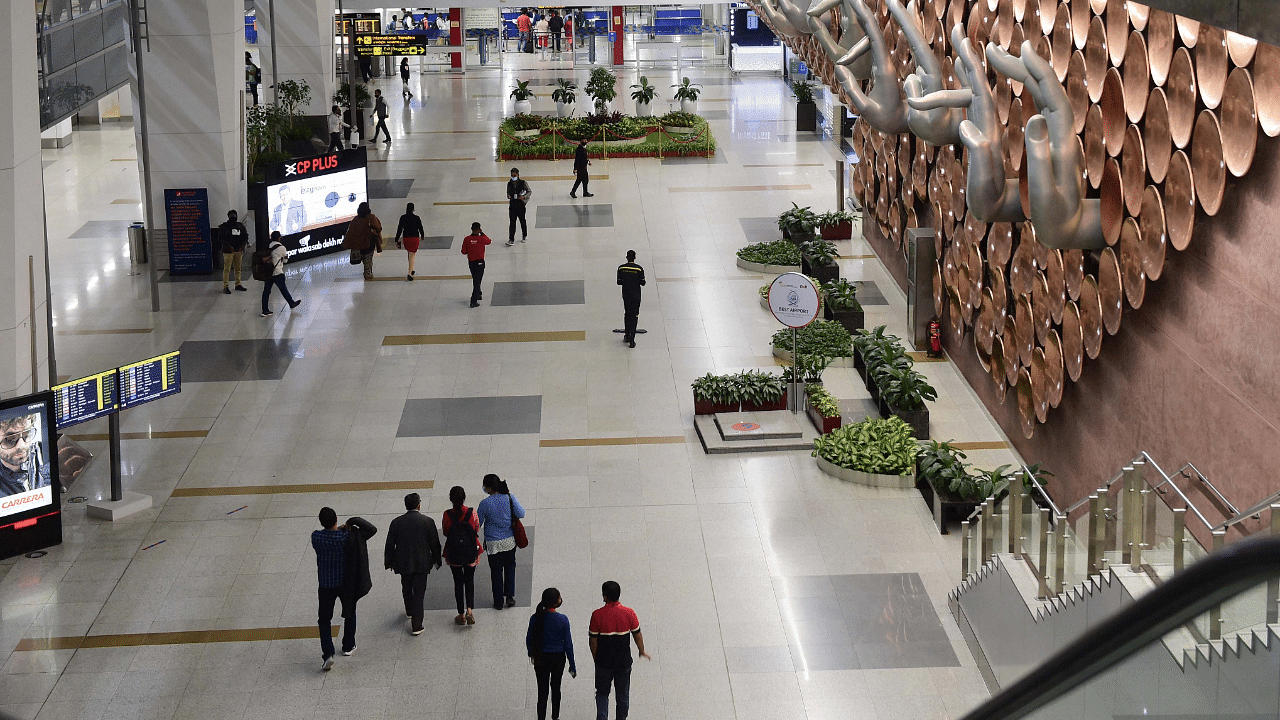
Passengers at Terminal 3 of the Delhi airport.
Credit: PTI Photo
New Delhi: The Delhi airport will be using predictive analytics based on artificial intelligence as well as camera-based solutions to improve operations at the airport, which is witnessing rising passenger traffic, according to a top official.
The airport, which is also the country's largest airport, handles around 1,300-1,500 flights daily and expects to have more than 70 million passenger traffic in the current fiscal ending March 2024. Currently, it has three terminals -- T1, T2 and T3.
"We are looking at more digital solutions, which can be IoT-based... Artificial Intelligence-based solutions... we will be using predictive analytics for improved airport operations," Delhi International Airport Ltd (DIAL) CEO Videh Kumar Jaipuriar told PTI in an interview.
The Indira Gandhi International Airport (IGIA) in the national capital is operated by Delhi International Airport Ltd (DIAL), a consortium led by the GMR Group.
Last year, during the winter season, the airport witnessed significant congestion, leading to long waiting times for passengers.
The DIAL chief said measures, including increasing the entry points, were taken within 15 days of the congestion that happened last year.
To ensure smooth passenger movements and improved operations, DIAL is upgrading to the system of APOC (Airports Operations Centre), which is already being used by some European airports and uses predictive analytics.
Elaborating on APOC, Jaipuriar said that for example, based on previous data, the system will predict that at a particular time frame, a certain number of footfalls is expected at the airport.
"To manage the x number of people during the waiting time, you need so many people at entry gates, check-in counters, CISF... it will give you a plan of the day and that plan can be given to the respective stakeholders so that they can plan their manpower accordingly. It is more like being pre-emptive on manpower deployment. That we are in the process of implementing," the DIAL chief said.
At T3, the airport operator has been using a system from Swiss manufacturer Xovis that is basically a camera-based solution. The system basically counts the people in different queues and then gives a predictive number about the waiting time in different queues.
"It is completely driven by Artificial Intelligence and based on the counting, it actually does the analytics and predicts that right now, you are joining the particular queue and what is the waiting time. It keeps on revalidating... we have increased the reach of that... we have put in at all the gates," Jaipuriar said.
The airport operator plans to use the system at T1 once its expansion is complete.
Besides, various camera-based solutions are being looked at for improving operations at the airport.
'With camera solutions, we are looking at many use cases. For example, the management of trollies. (And) some of the solutions are still in the making.
"We have smart cameras that can actually count the trollies in a trolly bank. In case, there are less number of trollies in a trolly bank, it sends a signal so that terminal operations people can fill that in. We are working on that solution," Jaipuriar said.
On the air side also, steps are being taken to further improve operations, including the use of a tool to track vehicles.
Based on the tracking devices, the tool gives a report on whether vehicles have deviated or not.
"It helps us in monitoring. It is an IoT (Internet of Things) device getting converted into artificial intelligence. It is already implemented for all the DIAL vehicles. We are looking at other stakeholders' vehicles... (such as) flight catering vehicles, cargo vehicles," Jaipuriar said.
In the current fiscal, Delhi Airport is expected to see passenger traffic higher than pre-Covid at more than 70 million.
Of the total, over 52 million will be domestic passengers, and around 18 million will be international passengers.
The expansion of T1 is likely to be completed by February-end next year. Once it is complete, the terminal's passenger handling capacity will increase from 17 million to 40 million, Jaipuriar said.
"Then, we will have an overall domestic capacity of 40 million in T1 and 25 million in T3. (Currently), the domestic capacity at T2 is 15 million," he said, adding that the international passenger handling capacity at T3 is around 20 million.
DIAL will also revisit its master plan for the airport that was prepared in 2016, and the current capacity levels are based on that plan.